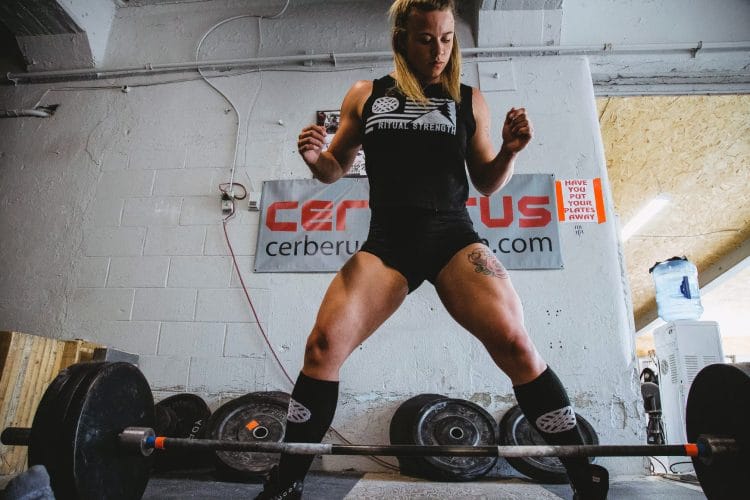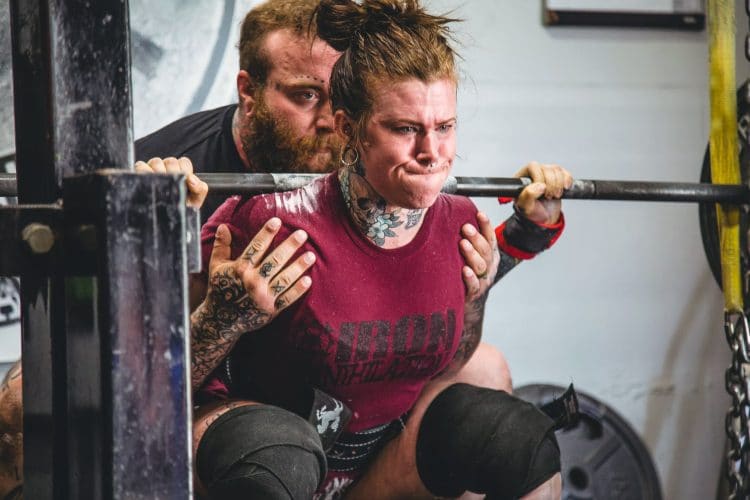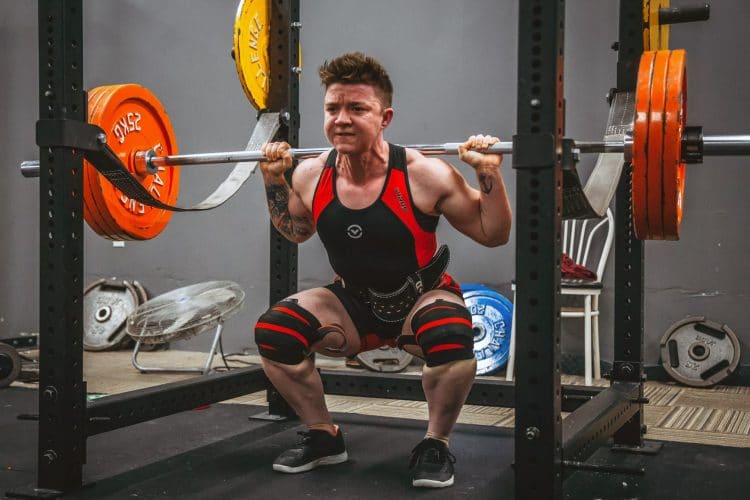At some point in a powerlifter’s career, there comes a time when progress doesn’t occur as frequently or with the amount of effort it used to take. When progress is no longer occurring on a weekly basis or even in single training sessions, a new approach must be taken. This is when a powerlifter goes from novice to intermediate status. While it can be frustrating to be experiencing stalled progress, it’s also a sign that great improvements have been made and that it’s time to take your training up a notch.
Whether your goal is to simply get stronger in the three main lifts, to make it to the platform for the first time, or to set a state or world record, keeping your body guessing with a more challenging program is a must.
Fortunately, there are a plethora of intermediate powerlifting programs to choose from that can take your training to the next level and ensure resuming progress. Each program has a different approach and varies in terms of length, rep range, volume and intensity but all with the same goal – to increase strength in the bench press, deadlift and squat. The key is to find a program that best works for you and one that you are most likely to stick to and complete.
When picking a new program, there are some key things to consider:
- How many days a week does this program require?
- How many days a week can I 100% commit to training?
- How much time per workout can I invest?
- How long is the training block and does that fit into my schedule? If you have a powerlift meet in 6 weeks, then the Strength Athlete (TSA) Intermediate Program v2.0, which is a duration of 9 weeks, is not an option to be considered
- Are there any core movements in this program that I am unable to perform (due to injury, etc.)?
Once you are able to ask yourself these questions and truthfully answer them, you can make a more informed decision about what program will best suit you. Let’s take a look at some of the most popular and widely used intermediate powerlifting programs.
These all vary in length and training days required:
- 5/3/1 Training Method
- Texas Method
- The Strength Athlete (TSA) Intermediate Program v 2.0
- Candito 6 Week Program
- Greg Nuckols Intermediate Program
- GZCL Jacked & Tan 2.0
5/3/1 Training Method – 1 Month Training Block
Snapshot:
- 3-4 days of training per week
- Each workout focuses on one of the core lifts
- Train with specific percentages of your one-rep max (1RM)
Level Up Your Fitness: Join our 💪 strong community in Fitness Volt Newsletter. Get daily inspiration, expert-backed workouts, nutrition tips, the latest in strength sports, and the support you need to reach your goals. Subscribe for free!
The general premise behind this training method is that the focus is on the basic principles of strength training and the four key exercises that are considered strength staples. Bench press, deadlifts and squats are the only competitive powerlifts, yes, but this program also incorporates a fourth movement – standing press. The 5/3/1 comes from the concept that during each training day, you should aim to perform 1(+), 3(+), or 5(+) reps per exercise, as prescribed. Let’s take a deeper dive:
Sample Training (1 Training Cycle):
- Week 1
- Set 1: 65% (of your 1 rep max) x 5
- Set 2: 75% (of your 1 rep max) x 5
- Set 3: 85% (of your 1 rep max) x 5
- Week 2
- Set 1: 70% (of your 1 rep max) x 3
- Set 2: 80% (of your 1 rep max) x 3
- Set 3: 90% (of your 1 rep max) x 3
- Week 3
- Set 1: 75% (of your 1 rep max) x 1
- Set 2: 85% (of your 1 rep max) x 1
- Set 3: 95% (of your 1 rep max) x 1
- Week 4
- Set 1: 40% (of your 1 rep max) x 5
- Set 2: 50% (of your 1 rep max) x 5
- Set 3: 60% (of your 1 rep max) x 5
Essentially, for four weeks, the weight used increases while the rep volume decreases. The fourth week is used for deload to give the body a break. Once the initial four weeks are over, you restart the cycle, but add 5 pounds to your one-rep max calculations from the prior training cycle (10 lbs for squats). If you started the first four weeks with 290lbs as your 1RM for squats, you would start the second four weeks using 300lbs as your 1RM base. For bench, deadlift and standing press, add 5lbs.
5/3/1 also incorporates accessory work to complement your training. This includes exercises such as dips, chin ups, good mornings, etc. Assistance work varies depending on what big lift the focus is on during each workout.
Related: nSuns 531 LP Powerlifting Program Guide with Spreadsheets
Texas Method – 1 Week Training Block
Snapshot:
- 3 days of training per week
- Each workout focuses on volume, active recovery, intensity and trains all 3 lifts each time
- Train with intentions of hitting new personal records (PRs) each week
The general premise behind this training method is getting through one training cycle each week (vs. a monthly training cycle, for example). The third training day of each cycle is the one in which a new PR attempt is made.
Sample Training (1 Training Cycle):
- Day 1: Volume
- Squat 5×5 @ 90% of 5 rep max (RM)
- Bench (or Standing) Press 5×5 @ 90% of 5RM
- Deadlift 5×5 @ 90% of 5RM
- Day 2: Active Recovery
- Squat 2×5 @ 80% of weight used on day 1
- Bench (or Standing) Press @ 90% of weight used on day 1
- Back Extension 5×10 (bodyweight)
- Day 3: Intensity
- Squat warm up, working sets to heavy single (new 5RM)
- Bench (or Standing) Press working sets to heavy single possible (new 5RM)
- Power Clean 5×3
Each training block takes one week to complete. Every time a new block is started, the idea is that the 5RM weight increases. The basic concept is that by increasing the load on each of the 3 (or 4) core exercises and consistently working these lifts, progress will occur. It’s normal for weekly progress to seem minimal, but week-over-week these small gains will add up to large increases in the powerlifts.
Level Up Your Fitness: Join our 💪 strong community in Fitness Volt Newsletter. Get daily inspiration, expert-backed workouts, nutrition tips, the latest in strength sports, and the support you need to reach your goals. Subscribe for free!
Related: The Texas Method
The Strength Athlete (TSA) Intermediate Program v2.0 – 9 Week Training Block
Snapshot:
- 4 days of training per week
- Each workout focuses on hypertrophy, power, or strength and trains all 1 or 2 of the main lifts each time
- Train with intentions of simulating a mock powerlift meet or entering an actual competition
The general premise behind this training method is to start with higher volume, lower weights, focus on deloading for a week, and then work to lower volume and higher weights during the latter part of the training block. Below is an abbreviated version of what this program looks like in the first four weeks, during deload, and in the last four weeks.
Sample Training (1 Training Cycle):
Hypertrophy:
- Day 1: Hypertrophy
- Squat 3×8 @ 70% of 1RM
- Bench (or Standing) Press 3×8 @ 70% of 1RM
- T-Bar Row 4×10-12
- Banded Face Pulls 3×30
- Day 2: Hypertrophy
- Deadlift 5×5 @ 75% of 1RM
- Bench Press @ 75% of 1RM
- Pendlay Row 3×5-7
- Pullups 3×30
- Day 3: Hypertrophy
- Squat 6×4 @ 75% of 1RM
- Leg Press 3×8-10
- T-Bar Row 3×10-12
- Chin Ups 3×30
- Day 4: Hypertrophy
- Bench Press 3×5 @ 80% of 1RM
- Pause Deadlifts 4×4 @ 70% of 1RM
- Pendlay Row 3×6-8
- Lat Pulldowns 3×10-12
Deload:
- Day 1: Deload
- Squat 3×5 @ 75% of 1RM
- Bench Press 3×6 @ 75% of 1RM
- T-Bar Row 4×8-10
- Face Pulls 3×30
- Day 2: Deload
- Deadlift 4×3 @ 80% of 1RM
- Bench Press 5×4 @ 80% of 1RM
- Pendlay Row 4×8-10
- Face Pulls 3×30
- Day 3: Deload
- Etc – Prepare for Intensity
- Day 4: Deload
- – Prepare for Intensity
Strength:
- Day 1: Strength
- Squat 5×3 @ 85% of 1RM
- Bench Press 4×6 @ 75% of 1RM
- Pendlay Row 4×8-10
- Face Pulls 3×30
- Day 2: Strength
- Deadlift 4×2 @ 85% of 1RM
- Bench Press 5×3 @ 85% of 1RM
- Pendlay Row 4×8-10
- Face Pulls 3×30
- Day 3: Strength
- Squat 5×3 @ 80% of 1RM
- Hack Squat 3×6-8
- T-Bar Row 3×8-10
- Chin Ups 3×8-10
- Day 4: Strength
- Bench Press 4×3 @ 85% of 1RM
- Feet Up Bench Press 3×5
- Paused Deadlift 5×2 @ 80% 1RM
- Pendlay Row 3×4-6
- Lat Pulldown 3×8-10
While the reps and sets vary slightly throughout each phase of this TSA Program, the general exercises in rotation stay the same. Accessory work is added in to help complement improving the big three lifts. The use of multiple rep range approaches allows for working on both maximum strength while also focusing on hypertrophy. Week five is a deload week, and also serves as a transition between the hypertrophy and strength phase.
While deload work can seem dull and boring, it’s a key piece in properly recovering and setting yourself up to really focus on making maximal gains as you enter your last four weeks of this training program.
Candito 6 Week Program – 6 Week Training Block
Snapshot:
- 2 days of training per week
- Each workout focuses on hypertrophy, power, or conditioning and trains only 1 specific main lift throughout the entire program
- Train with intentions of increasing your 1RM at the end of the training block
You will cycle through several brief training blocks throughout this program. These blocks consist of muscular conditioning, hypertrophy, strength, linear weight increases, getting accustomed to heavy weights, intensity and setting 1RMs. Periodization is the key component of this training program.
Sample Training (6 Week Training Cycle):
- Week 1: Muscular Conditioning
- 4 Sets with Rep Ranges of 8-12
- Week 2: Hypertrophy
- 3 Sets with Rep Ranges of 8-12
- Week 3: Linear Max
- 3 Sets with Rep Ranges of 4-6
- Week 4: Heavy Weight Acclimation/Explosiveness
- 3 & 4 Sets with Rep Ranges of 3-6 & 10-12
- Week 5: Intense Strength Training
- 1 & 3 Sets with Rep Ranges of 3-6 & 10-12
- Week 6: Deload (Optional)
- 1 Set to Find 1RM
The general premise behind this program is unique. This specific Candito Program is more tailored towards powerlifters who prefer to compete in single or two lift competitions. Essentially, a “full power” powerlift meet means a lifter will compete in squat, bench and deadlift.
Many competitions also offer “push-pull” categories (bench press and deadlift only, no squat) or single lift categories (squat only, bench only, deadlift only). If you find yourself to be more of a single lift competitor, this program is likely a great fit.
Related: 5 Essential Candito Training Programs For Powerlifters
The Key Takeaways
Implementing a new powerlift program is the best way to ensure both short- and long-term strength improvements. Regardless of competition status – whether you’ve done powerlift meets before, have just thought about it, or aren’t interested at all, it’s likely that strength gains in the bench press, deadlift and squat are the ultimate goals.
- Find a program that suits you: ensure you can commit to the number of workouts per week and the time required to carry out the exercises
- Keep the end goal in mind: if you are heading into a powerlift meet in the near future, find a program (like the TSA Intermediate Program v2.0) that trains you right up to a competition date
- Stick to it: it can be frustrating and even intimidating to start something new, but the only way to know if a specific program is right for you is to follow-through and complete it
- Track your progress: there are many resources and pre-filled templates that can serve as free tools to track your progress as you move through a new program
- Assess the results: once you complete an intermediate powerlifting program, evaluate your progress to determine your success, shortcomings, and what the next steps are
Implementing a new intermediate powerlifting program is the best way to ensure both short- and long-term strength improvements. Armed with the proper knowledge and resources, you can be on your way to big strength gains in no time.












Hi – I am a female weightlfiter new to the sport and I’m wondering how many tattoos I should get and where is the best bodypart to get them? Thank you.
Tattoos are a personal preference, consider visibility while competing. Number of tattoos is up to you and make sure you are comfortable with your decision. Good luck on your weightlifting journey!